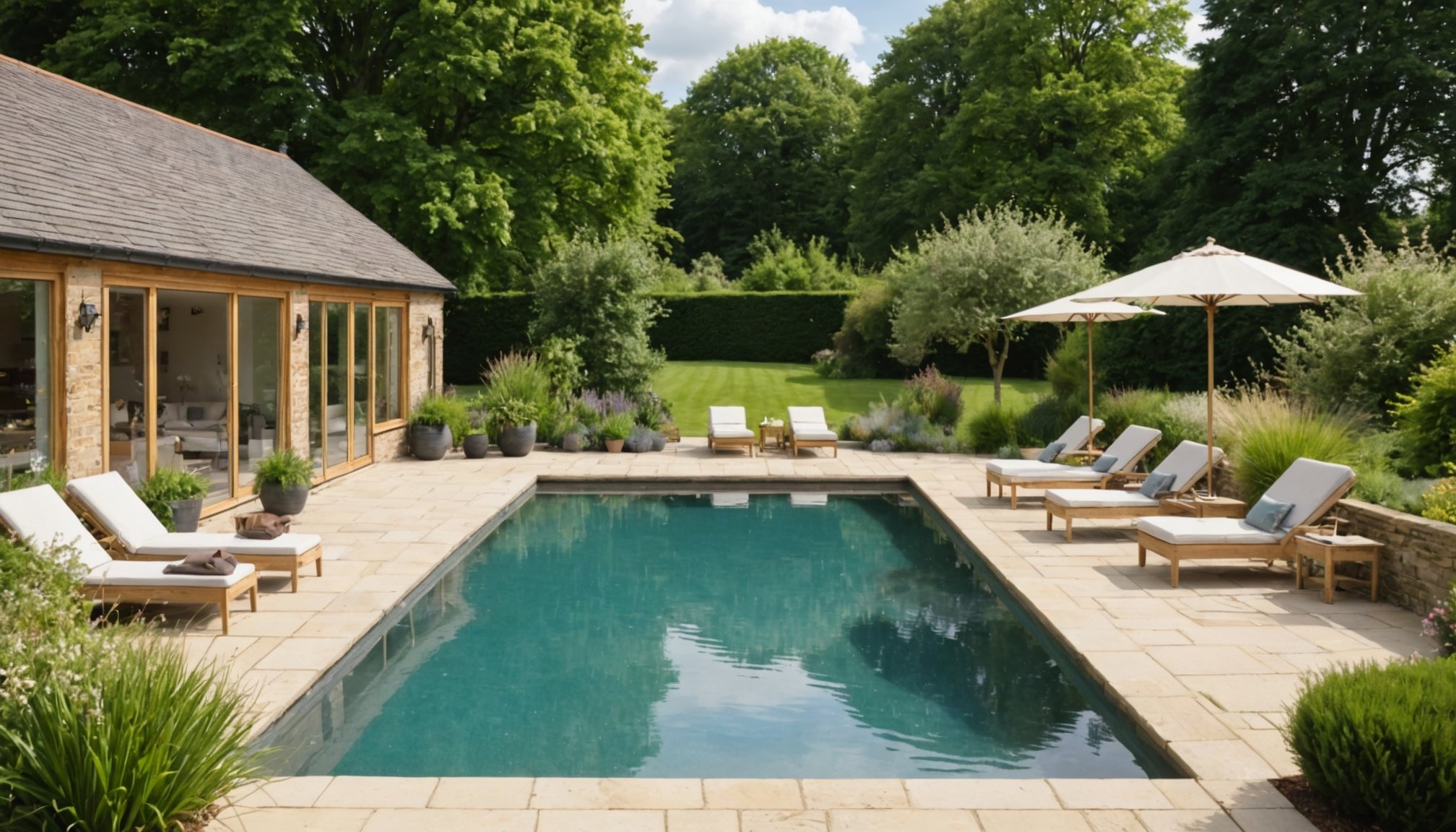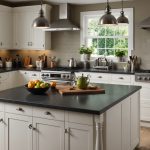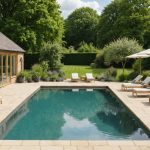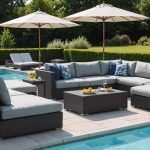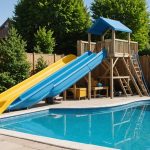Designing Aesthetic Harmony with Nature
Creating a natural swimming pool design that complements the idyllic beauty of the UK countryside is an art. The primary goal is to ensure the pool blends seamlessly with the surrounding landscapes, enhancing rather than disrupting the natural view.
Key Design Elements
-
Shape and Placement: It’s vital to choose organic, flowing shapes for the pool. Consider its placement to work with natural contours of the land, enabling aesthetic harmony.
In parallel : Essential Tips for Complying with UK Safety Standards When Installing Your Pool Slide
-
Materials and Colours: Opt for local and natural materials—consider stones or pebbles native to the area. Subtle colours and textures will help the pool merge with its environment.
-
Plant Integration: Incorporating local plant species around and within the pool not only enhances visual appeal but also supports the local ecology.
Also to read : Ultimate Guide to Ensuring Your Poolside Furniture Stands Up to the UK”s Unpredictable Weather
UK Success Stories
Some exemplary natural pool projects in the UK showcase beautiful integration. For instance, pools that incorporate local flora and take cues from surrounding foliage demonstrate how successful designs achieve a stunning balance. This results in an oasis that respects and reflects its region’s natural beauty, encouraging harmony between human-made structures and nature.
Material Choices for Rural Settings
When designing a pool in a rural setting, selecting the right materials can enhance the landscape’s natural beauty. Choosing eco-friendly materials not only complements the environment but also demonstrates a commitment to sustainability. Common options include natural stone, wood, and certain renovated metals that blend seamlessly with the countryside’s charm.
Sustainable pool construction can be achieved with innovative materials that have minimal environmental impact. These materials are not only long-lasting but also reduce the carbon footprint of the pool project. For instance, reclaimed wood can add rustic appeal, while recycled concrete and bricks provide a durable foundation without depleting resources.
Benefits of Eco-Friendly Choices
Using eco-friendly materials boasts several advantages:
- Reduces environmental impact and often requires less maintenance.
- Enhances aesthetic appeal, blending harmoniously with the natural surroundings.
- Offers potential financial savings by lowering long-term maintenance costs.
Case studies highlight pools integrated into rural settings, demonstrating the practical application of these materials. One example involves a countryside estate utilizing local stones and reclaimed timber, resulting in a stunning yet environmentally conscious swimming pool design. These materials, paired with native plants, create a breathtaking visual symphony that respects the natural beauty and sustainability ethos of rural living.
Landscaping Ideas to Enhance Pool Integration
Designing outdoor spaces around a natural pool requires strategic thinking to achieve a cohesive environment. Eco-landscaping, which incorporates harmonious design elements, is essential. Begin with selecting native plants that thrive in your environment, as they require less maintenance and water. This not only enhances the natural beauty of the landscape but also supports local biodiversity.
Garden design near pools can benefit from the use of natural stones and boulders. These elements provide a sense of permanence and durability. By carefully positioning boulders, you mimic natural water formations, improving the aesthetic while offering seating or even a playful climbing structure for children.
When considering landscaping for natural pools, it’s crucial to create transition areas between water and garden. The goal is to blend these spaces seamlessly. Use pathways and stepping stones to guide household members and visitors across your outdoor terrain, ensuring it feels inviting and accessible. Remember, it’s about creating a balance between beauty and functionality.
Sustainability Practices for Pool Design
Creating an energy-efficient pool begins with eco-friendly installation. Integrating renewable energy options, such as solar panels for heating, can significantly lower energy consumption. Solar heating systems harness the sun’s power, offering a cleaner alternative to traditional fossil fuels. Additionally, consider using variable speed pumps, which adjust to the pool’s needs and significantly reduce energy usage.
Water conservation techniques are paramount for sustainable pool practices. Implementing rainwater harvesting systems allows pool owners to collect and utilise rainwater. This not only conserves water but also reduces dependency on municipal sources. Installing a backwash recovery system is another effective method, as it filters and reuses pool water instead of discarding it.
Maintaining an ecological balance within and around the pool is crucial. This includes avoiding chemical overuse, which can harm both the pool environment and local ecosystems. Alternatively, natural pool designs incorporate plants and bio-filters that cleanse the water naturally, promoting healthier habitats. Selecting native plants around the pool area enhances local biodiversity while requiring less water and maintenance. Through these sustainable pool practices, pool owners can enjoy a refreshing swim while respecting the environment. Embracing these strategies ensures both enjoyment and responsibility in pool ownership.
Practical Steps for Implementation
Embarking on a DIY pool design journey requires careful planning and execution. Start by developing a pool installation guide to serve as your roadmap. This guide should detail key steps such as selecting an appropriate site, drafting the pool dimensions, and determining the materials needed. Incorporating practical design tips, like integrating natural filtration systems, can enhance both the sustainability and aesthetic appeal of your pool.
Budgeting is an essential aspect of pool installation. Being mindful of costs allows for more cost-effective options, ensuring quality without overspending. Consider using recycled materials or opting for a smaller pool size to effectively manage expenses while still achieving your desired outcome.
Maintenance is the key to ensuring your pool remains both sustainable and attractive over time. Regularly clean filter systems, and balance water chemistry to prevent algae growth and water cloudiness. Sustainable practices, such as planting aquatic vegetation or using rainwater harvesting methods, contribute to the long-term viability of your DIY project.
Incorporating these steps ensures a successful pool installation that aligns with both your aesthetic desires and financial constraints, all while maintaining environmental consciousness.
Case Studies and Inspiration
Drawing inspiration from real-life examples can fuel creativity and direction for your own pool design. In the UK countryside, several notable projects stand out. They beautifully integrate each pool into its natural surroundings, creating a seamless blend between the designed and the organic. Let’s explore a few highlights that could serve as your next source of pool design inspiration.
One striking example is a project nestled in the Cotswolds, where the pool mirrors the rolling hills. The thoughtful placement and choice of materials enhance the natural beauty of the landscape. Interviews with the designers reveal the importance of aligning the pool’s aesthetics with the local environment.
In another countryside pool project in Devon, homeowners embraced eco-friendly materials and features, ensuring their pool was not only stunning but also sustainable. These personal insights tune us into critical aspects of design that harmonise with ecological concerns.
Visual showcases of these countryside pool projects reveal intricate details, from natural stone borders to lush green surroundings. These elements contribute to the ultimate goal: creating pools that do not just occupy space, but rather, enrich it. By studying these projects, one can glean how to intertwine functionality with nature, achieving a perfect balance.

